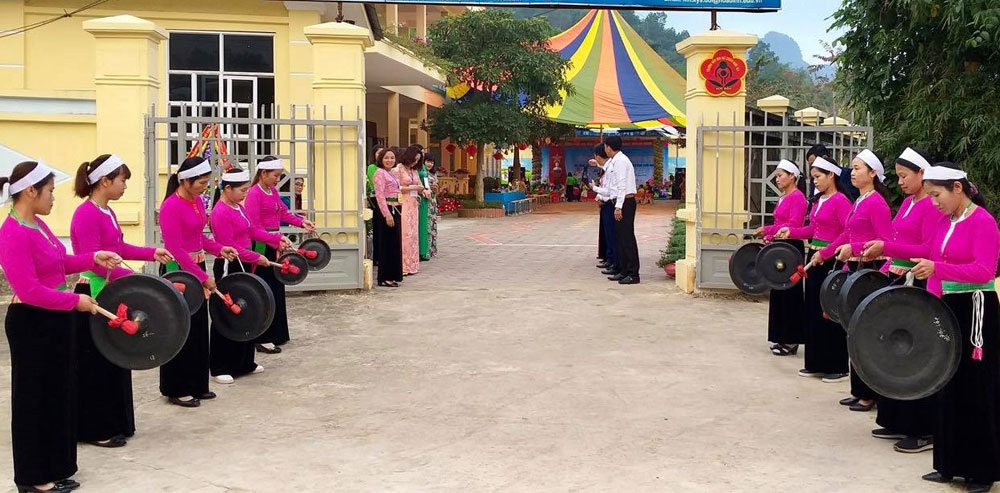
(HBO) – Up to 91 percent of the households of the specially disadvantaged commune of Doc Lap in Hoa Binh city belong to the Muong ethnic minority group and 7.3 percent to the Dao. Many of their cultural identities are still preserved today as seen in their languages, customs, and daily life activities. Besides, cultural and sports activities have also greatly helped with promoting those values.
.jpg) The gong team of Noi hamlet in Doc Lap commune (Hoa
Binh city) has regularly practiced and performed at festivals and other events,
helping to honour and preserve cultural values.
The gong team of Noi hamlet in Doc Lap commune (Hoa
Binh city) has regularly practiced and performed at festivals and other events,
helping to honour and preserve cultural values.
Bestowed with favourable conditions for
socio-economic development in all fields, Can hamlet is also known as one of
the Muong ethnic villages with rich identity. Not only using the Muong language
in their daily life, local residents also frequently wear traditional costumes
on big events, anniversaries, and festivals.
Dinh Van Minh, Secretary of the Party cell of Can
hamlet, said locals have stayed united to assist one another in economic
development and carry out movements and campaigns, including those on
developing a civilised lifestyle, abolishing backward customs, combating
crimes, and upholding cultural identities.
A club of traditional culture was established
here, attracting a large number of local residents, he said, noting that the
gong team of the elderly and cultural teams of women and young people have
shown many unique singing, dancing, and instrumental performances.
Muong Dao, a less privileged hamlet, derives its
name from those of the two ethnic groups residing here. Among the 170 local
households, 123 are from the Muong ethnic minority group and the rest, from the
Dao.
Nguyen Dinh Tuong, Secretary of the Party cell
of Muong Dao hamlet, said Dao people are well aware of the importance of
preserving their cultural identities. likewise, Muong people also respect and
maintain their group’s traditional cultural practices.
He added that the solidarity among the local
ethnic groups could be seen via cultural and sports activities at the great
national solidarity festival held in November 2020.
The preservation of cultural identities in
mountainous Doc Lap commune has spread across the remaining hamlets of Noi,
Nua, Mui, and Song.
Vice Chairman of the communal People’s Committee
Nguyen Van Phong said every year, local authorities build and implement plans
to uphold and bring into play traditional cultural identities.
Communications have been stepped up via local
meetings and campaigns. In particular, the Doc Lap Primary and Junior High
School has organised extracurricular sessions to educate students on conserving
the Muong culture, which have engaged hundreds of teachers and students,
according to the official.
Besides, sports activities have also helped with
cultural conservation. Folk sports like cane pushing, crossbow shooting, and
stilt walking have proved attractive to local residents.
This year, due to complex developments of
COVID-19, cultural activities have been suspended since the year’s beginning to
minimise mass gatherings.
Earlier, a wide range of cultural and sports
activities were held at the great national solidarity festival in late 2020,
helping to preserve and honour cultural identities of local Muong and Dao
people./.
With an increasingly vibrant and widespread emulation movement aimed at building cultured residential areas and cultured families, Yen Thuy District has been making steady progress toward improving both the material and spiritual well-being of its people, while fostering a civilized, prosperous, beautiful, and progressive community.
Once lacking recreational spaces and community facilities, Residential Group 2 in Quynh Lam Ward (Hoa Binh City) has recently received attention for the construction of a new, spacious, and fully equipped cultural house. The project followed the model of state support combined with public contributions in both labor and funding.
The "All people unite to build cultural life" movement, which has been effectively integrated with Kim Boi district’s socio-economic development goals, is fostering a lively spirit of emulation across local residential areas, hamlets, villages, public agencies, and enterprises. In addition, through the initiative, traditional cultural values are being preserved and promoted, while community solidarity and mutual support in poverty reduction and economic development are being strengthened.
A working delegation of the Hoa Binh provincial People’s Committee led by its Permanent Vice Chairman Nguyen Van Toan on June 11 inspected the progress of a project to build the Mo Muong Cultural Heritage Conservation Space linked to tourism services in Hop Phong commune, Cao Phong district.
Born and growing in the heroic land of Muong Dong, Dinh Thi Kieu Dung, a resident in Bo town of Kim Boi district, in her childhood was nurtured by the sweet lullabies of her grandmother and mother. These melodies deeply imprinted on her soul, becoming an inseparable part of her love for her ethnic group's culture. For over 20 years, this love for her hometown has driven Dung to research, collect, and pass down the cultural values of the Muong people to future generations.
In the final days of May, the Ethnic Art Troupe of Hoa Binh Province organized performances to serve the people in remote, mountainous, and particularly disadvantaged areas within the province. These were not just ordinary artistic shows, but they were the meaningful journeys aimed at spreading cultural values, enhancing the spiritual life of the people and contributing to the preservation of ethnic minority cultural identities.



.jpg) The gong team of Noi hamlet in Doc Lap commune (Hoa
Binh city) has regularly practiced and performed at festivals and other events,
helping to honour and preserve cultural values.
The gong team of Noi hamlet in Doc Lap commune (Hoa
Binh city) has regularly practiced and performed at festivals and other events,
helping to honour and preserve cultural values.